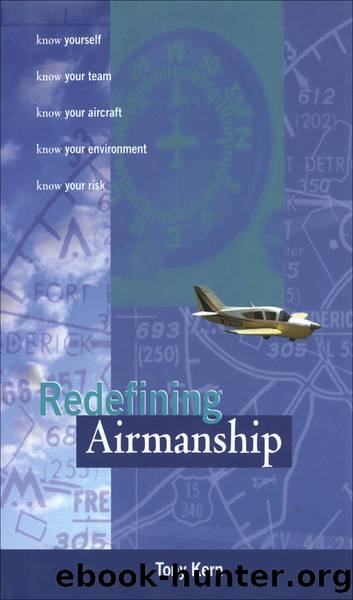Redefining Airmanship by Tony T. Kern

Author:Tony T. Kern
Language: eng
Format: epub
Publisher: McGraw Hill LLC
Published: 1997-01-15T00:00:00+00:00
Maintenance factors
Even the best designed and equipped aircraft can become a death trap if it is poorly maintained, and maintenance factors must be considered when we assess aircraft risk. But this can be a difficult task for many pilots and other flight crewmembers, who are often not mechanically inclined or trained to make difficult systems assessments. Four areas can be looked into by the novice: documentation, time, parts, and servicing.
All aircraft are required to maintain detailed maintenance records. As operators, we must be fully conversant with what the various parts of this documentation mean to us. There will likely still remain some areas that remain mystical and shrouded in secrecy by the âbrotherhood of the wrench.â Ask questions until you receive satisfactory answers. At a minimum, we must be able to determine if the aircraft meets current inspection requirements, has been preflighted, and what the recent maintenance discrepancies have been.
The second area of concern for the operator should be the airframe time, usually measured in flight hours. This is not just a âtotal hourâ concern but can indicate other high-risk events in an aircraftâs life cycle. For example, we should be suspicious of an aircraft that has not flown recently. Why hasnât anyone flown it lately? Was it down for repairs? If so, what were they? Is there a problem with the aircraft that has caused others to refuse to fly it?
Likewise, care should be taken when flying a brand-new aircraft or one that has just returned from a âphase inspection,â teardown, or overhaul. These are the times when the aircraft has been visited by many specialists and âknucklebusters,â all who attempt to do a good job, but the risk of error is increased by the many operations that are required during these inspections. The flights that immediately follow these inspections are when maintenance-related failures are most likely to occur.
Closely related to documentation are aircraft parts and servicing. Any replaced or repaired part should be viewed as the source of a potential hazard, and most pilots in command will go as far as making these mandatory briefing items to the rest of the crew. Additionally, aircraft servicing should be carefully checked, not just to see that it was done, but to ensure that it was done correctly. Keep in mind that the servicing specialists are often the most junior and least skilled members of the maintenance team, as well as often being the most overworked and time-stressed. This combination can lead to problems of under- or overservicing or failure to close up servicing access caps, doors, and panels.
Download
This site does not store any files on its server. We only index and link to content provided by other sites. Please contact the content providers to delete copyright contents if any and email us, we'll remove relevant links or contents immediately.
| Automotive | Engineering |
| Transportation |
Whiskies Galore by Ian Buxton(41517)
Introduction to Aircraft Design (Cambridge Aerospace Series) by John P. Fielding(32879)
Small Unmanned Fixed-wing Aircraft Design by Andrew J. Keane Andras Sobester James P. Scanlan & András Sóbester & James P. Scanlan(32562)
Craft Beer for the Homebrewer by Michael Agnew(17921)
Turbulence by E. J. Noyes(7687)
The Complete Stick Figure Physics Tutorials by Allen Sarah(7132)
Kaplan MCAT General Chemistry Review by Kaplan(6579)
The Thirst by Nesbo Jo(6427)
Bad Blood by John Carreyrou(6265)
Modelling of Convective Heat and Mass Transfer in Rotating Flows by Igor V. Shevchuk(6216)
Learning SQL by Alan Beaulieu(6019)
Weapons of Math Destruction by Cathy O'Neil(5812)
Man-made Catastrophes and Risk Information Concealment by Dmitry Chernov & Didier Sornette(5635)
Digital Minimalism by Cal Newport;(5368)
Life 3.0: Being Human in the Age of Artificial Intelligence by Tegmark Max(5171)
iGen by Jean M. Twenge(5147)
Secrets of Antigravity Propulsion: Tesla, UFOs, and Classified Aerospace Technology by Ph.D. Paul A. Laviolette(4968)
Design of Trajectory Optimization Approach for Space Maneuver Vehicle Skip Entry Problems by Runqi Chai & Al Savvaris & Antonios Tsourdos & Senchun Chai(4835)
Electronic Devices & Circuits by Jacob Millman & Christos C. Halkias(4735)
